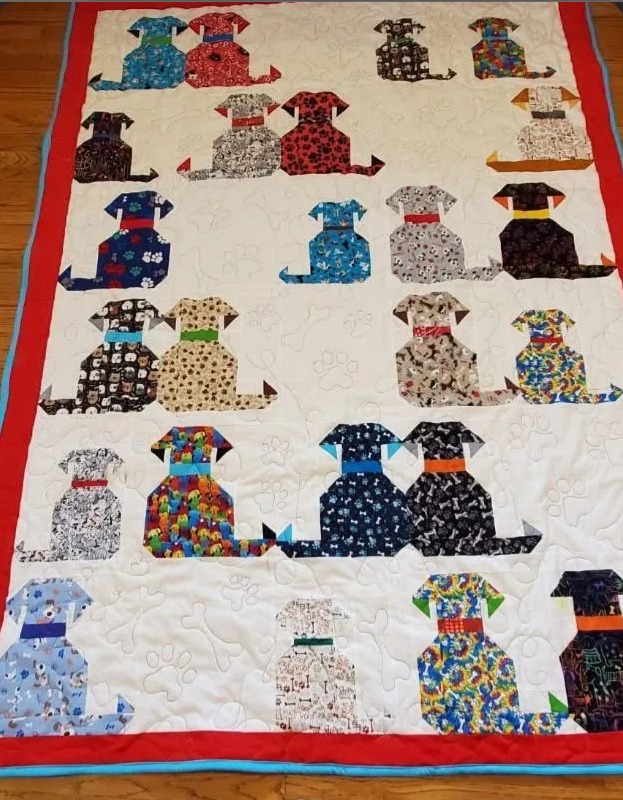The Sawtooth Star Quilt Pattern is one of the most iconic and beloved designs in the world of quilting. This timeless pattern has captured the hearts of quilters for generations, combining classic beauty with endless creative possibilities.
The beauty of the Sawtooth Star Quilt Pattern lies in its versatility. It can be adapted to a variety of styles, from rustic farmhouse aesthetics to sleek contemporary interiors. By simply changing fabric colors and arrangements, quilters can transform this traditional design into something completely unique.
When it comes to learning and creating, the Sawtooth Star Quilt Pattern offers a wonderful introduction to essential quilting techniques. It teaches precision cutting, accurate piecing, and careful pressing — all crucial skills for any quilter.

The Origins and History of the Sawtooth Star Quilt Pattern
The Sawtooth Star Quilt Pattern has a rich history that dates back to the early 1800s. Its roots can be traced to pioneer times when resourceful homemakers used every scrap of fabric they could find to create warm and decorative quilts. The star motif has always held symbolic importance in American folk art, often representing navigation, dreams, and freedom. As quilting communities grew, the Sawtooth Star quickly became one of the most recognizable and cherished block designs.
Many early Sawtooth Star quilts were created by hand using simple tools and limited materials. Quilters relied on precise measurements and an eye for symmetry to achieve the clean, geometric appearance that defines this pattern. The design was passed down through generations, often used to mark important life events such as weddings, births, and anniversaries. Each quilt told a story, blending practical function with emotional significance.
As time progressed, the Sawtooth Star Quilt Pattern evolved with new fabrics, technologies, and artistic influences. During the 20th century, machine sewing and rotary cutting tools made it easier for quilters to create accurate blocks faster than ever before. Despite these innovations, the pattern retained its vintage charm and remained a favorite among traditionalists. Today, modern quilters reinterpret the Sawtooth Star with bold colors, abstract layouts, and contemporary fabrics, proving its timeless appeal.
One reason for the pattern’s enduring popularity is its adaptability. It can be scaled up or down depending on the project’s size, from small mug rugs to full-sized quilts. Its modular structure allows endless creativity — you can combine multiple stars, play with negative space, or mix it with other quilt blocks to create visually stunning effects. This versatility keeps the Sawtooth Star Quilt Pattern relevant and exciting for quilters of all skill levels.
How to Make a Sawtooth Star Quilt Block
Creating a Sawtooth Star Quilt Pattern block may look complicated at first, but it’s surprisingly beginner-friendly once you understand the structure. Each block typically consists of nine squares arranged in a 3×3 grid, with the center square surrounded by star points made from half-square triangles. The process involves careful cutting, piecing, and pressing — all of which are essential skills for any quilter.
To start, select your fabrics. Most Sawtooth Stars use at least two contrasting fabrics — one for the star and another for the background. However, you can experiment with multiple colors or even patterned fabrics to add visual depth. Pre-washing and pressing your fabric ensures smooth cutting and accurate measurements. A clean and organized workspace also helps maintain precision.
Next, cut your pieces according to the desired block size. Common sizes include 6”, 9”, or 12” finished squares. The key elements are the center square, four corner squares, and four flying geese units. The flying geese form the star points, which give the Sawtooth Star Quilt Pattern its distinct shape. Using a rotary cutter and a ruler helps ensure crisp, straight edges for perfect alignment.
Once your pieces are ready, start assembling the block. Begin by sewing the flying geese units to the center square to form the star points. Then, add the corner squares to complete the outer frame. Always press your seams carefully to keep everything flat and smooth. Precision pressing can make a significant difference in the final look of your quilt.
When sewing multiple blocks, maintaining a consistent seam allowance is crucial. Most quilters use a ¼” seam for accuracy. Consistency ensures that all your blocks will fit together perfectly when joined. If your seams are off, the overall pattern may appear distorted or uneven. Always double-check measurements before final assembly.
Tips for Choosing Fabrics and Colors
Selecting the right fabrics and colors can transform your Sawtooth Star Quilt Pattern from simple to stunning. The interplay of tones, textures, and prints can dramatically affect the final look of your quilt. Whether you prefer soft pastels, vibrant hues, or neutral shades, choosing colors thoughtfully will enhance your design’s visual appeal.
Start by deciding on a color palette. Many quilters use the color wheel as a guide to create harmonious combinations. Complementary colors, such as blue and orange or red and green, create high contrast and make the star pop. Analogous colors, like shades of blue and teal, offer a more subtle and soothing effect. The background color is equally important, as it frames the star and influences how bright or muted the overall design appears.
Texture and fabric type also play a vital role. Cotton is the most popular material for quilting because it’s durable, easy to work with, and available in countless patterns. You can also incorporate batiks, solids, or small prints to add interest. Mixing textures gives depth and dimension to your quilt, making it visually engaging from every angle.
If you’re creating a Sawtooth Star Quilt Pattern for a specific theme, such as holidays or seasons, choose fabrics that reflect that mood. For example, red, white, and blue stars evoke a patriotic feel, while earthy tones can create a cozy, rustic look. Floral prints work beautifully for spring, and jewel tones add elegance and sophistication.
Another valuable tip is to test your fabric combinations before cutting. Lay out your choices together to see how they interact under natural light. Sometimes colors that look perfect in theory might clash in practice. Making small test blocks can help you visualize the final result and avoid disappointment later.
Lastly, don’t be afraid to experiment. Some of the most breathtaking Sawtooth Star Quilt Patterns come from bold and unexpected fabric choices. Trust your instincts and have fun with the creative process — after all, quilting is both an art and a form of self-expression.
Finishing and Displaying Your Sawtooth Star Quilt
After piecing your Sawtooth Star Quilt Pattern, it’s time to quilt and finish your masterpiece. This stage brings texture, structure, and personality to your project. You can choose from hand quilting, machine quilting, or even long-arm quilting depending on your preference and resources. Each technique adds a unique touch to the final look.
Before quilting, prepare your quilt sandwich by layering the top, batting, and backing fabrics. Secure them with pins or basting spray to prevent shifting. Smooth out any wrinkles carefully to ensure even stitching. Taking your time during this step ensures a professional finish later on.
When it comes to quilting designs, simple straight-line stitching enhances the geometric beauty of the Sawtooth Star Quilt Pattern, while free-motion quilting can add artistic flair. Follow the lines of the stars or create intricate motifs between them for added charm. Experimenting with thread color can also elevate your quilt’s overall aesthetic.
FAQ – Sawtooth Star Quilt Pattern
1. What size should I make my Sawtooth Star blocks?
Common sizes are 6”, 9”, and 12” finished blocks, but you can easily adjust the measurements to fit your project.
2. Is the Sawtooth Star Quilt Pattern good for beginners?
Yes! It’s one of the best beginner-friendly patterns because it teaches essential quilting skills like cutting, piecing, and pressing.
3. Can I make a Sawtooth Star using scraps?
Absolutely. This pattern is perfect for scrap quilting, allowing you to use leftover fabrics creatively.
4. What is the easiest way to make flying geese units?
The four-at-a-time method is popular because it saves time and ensures uniform shapes without fabric waste.
Conclusion
The Sawtooth Star Quilt Pattern remains a timeless favorite among quilters for good reason. Its simplicity, versatility, and stunning visual impact make it a project that every quilting enthusiast should try at least once. From its rich history to its endless modern adaptations, the pattern bridges tradition and creativity in a truly beautiful way.



